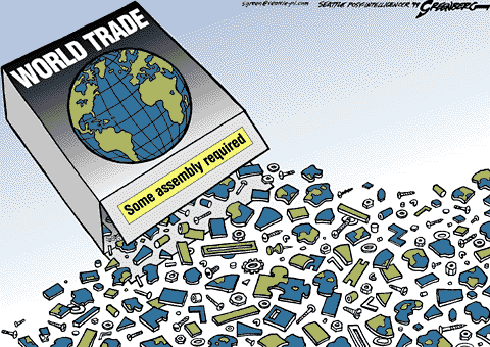Tariff or No Tariff? Pick one.
Discussing the consequences of uncertainty surrounding trade policy
Today as a thought experiment in my course titled “Advanced Topics in Trade Theory” course with Professor Mine Senses at Johns Hopkins University SAIS, we began with the discussion question: “What are some of the costs of trade policy uncertainty”. I want to use this space as a way for not only me to make sense of the question, but for the reader to make sense of it too.
First, it’s important to clarify that we’re talking about the big picture here. Trade policies and tariffs can affect specific industries or groups of people in different ways, and those individual impacts are often overlooked. However, this will focus on the overall effects of tariffs on the economy as a whole, not on how they might hurt or help particular businesses or individuals. Figuring out how to address those specific impacts is an important job of policymakers (they have done a terrible job in the past).
Uncertainty about trade policies makes businesses hesitant to invest and hire.
When businesses don’t know what trade policies will look like in the future, they become hesitant to make big investments or hire new workers. For example, if a company isn’t sure whether tariffs will make imported materials more expensive, it might delay building a new factory or upgrading its equipment. This hesitation slows down economic growth because businesses aren’t spending money or creating jobs. It also affects hiring—companies might hold off on bringing in new employees or offering training programs because they’re worried about future costs. In short, uncertainty about trade policies makes businesses play it safe, which can hurt the economy and limit opportunities for workers.
Unpredictable prices and supply chain chaos hurt businesses.
When trade policies are unclear, it creates chaos for prices and supply chains. For example, if companies aren’t sure whether tariffs will make imported materials more expensive, they might rush to stock up on supplies before prices go up. This can lead to shortages and increase costs in the short term. At the same time, businesses might try to find new suppliers or switch to different materials, which can be expensive and time-consuming. On top of that, the prices of goods and materials can swing wildly because of uncertainty, making it hard for businesses to plan their budgets or set prices for their products. All of this adds up to higher costs, more stress, and less efficiency for businesses trying to navigate an unpredictable trade environment.
Uncertainty creates confusion without helping government finances.
When trade policies are unclear, it also creates a lot of confusion for businesses and consumers, and it doesn’t even help the government’s finances. For example, if people aren’t sure whether tariffs will be put in place, they might hold off on buying goods or making investments. This hesitation can distort markets—meaning things don’t work the way they’re supposed to. Prices might go up or down unpredictably, and businesses might struggle to sell their products. The worst part is, even though tariffs are supposed to bring in money for the government, the uncertainty around them often doesn’t lead to any extra revenue. Instead, it just creates a mess where everyone is unsure what to do, and the economy doesn’t benefit. In short, uncertainty hurts businesses and consumers without giving the government the financial boost it was hoping for.
Tariffs and Uncertainty make prices less predictable, hurting everyone.
Tariffs and uncertainty about trade policies make prices harder to predict, and that’s bad news for everyone. Tariffs—taxes on imported goods—tend to raise the average cost of products, making things more expensive for businesses and consumers. But when there’s also uncertainty about whether tariffs will happen or how long they’ll last, prices can swing wildly up and down. This unpredictability makes it hard for businesses to plan their budgets or set prices for their products. For example, a company might not know how much it will cost to buy materials next month, so it has to guess—and those guesses can lead to higher prices for customers. Families also feel the pinch because they can’t plan their spending when prices keep changing. In the end, tariffs and uncertainty create a lose-lose situation where everyone ends up paying more and dealing with unnecessary stress.
Where do we go from here?
Just days after announcing a 25% tariff on imports from Canada and Mexico, President Donald Trump agreed to delay the tariffs for one month after both countries promised to tighten security at their borders. This temporary pause avoided what could have been a major economic headache—higher prices for U.S. consumers and a slowdown in trade between the three countries. Canada pledged $1.3 billion to boost border security, including new technology and personnel to stop the flow of drugs like fentanyl, a plan proposed last December. Mexico also promised to send 10,000 members of its national guard to its northern border to crack down on drug trafficking and the flow of migrants in exchange for help in slowing down weapon flows to Latin America. While the delay eased some immediate concerns, the threat of tariffs still looms, putting many long-term decision in limbo. What will President Trump decide? Who knows. One thing he cannot afford is to continue the uncertain future with the United States closest trade partners, as it will have increasingly severe repercussions.
Research warns that threats to abandon or renegotiate trade agreements—like what happened with Brexit—can create uncertainty that unnecessarily hurts consumers and businesses. Even if no tariffs are actually imposed, the mere threat of them can disrupt trade, raise prices, and slow economic growth. Moving forward, policymakers should focus on maintaining stable trade agreements and reducing uncertainty to protect consumer welfare and support businesses. While tariffs and trade policies are important, the uncertainty surrounding them can be just as damaging—if not more—to the economy.





